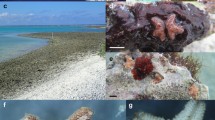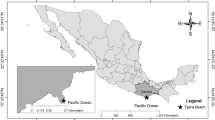Abstract
Asexual and sexual reproduction were studied in an intertidal population of Nepanthia belcheri (Perrier) at Townsville, Queensland, Australia, by regular sampling over a year (March 1976-March 1977) and by histological analysis of gonads. Fission reached a peak in early winter (April–June), when about 45% of the population showed evidence of recent fission. Propensity for fission was unrelated to longest arm length. Seven-armed seastars predominated in the population and these underwent fission in two stages to produce one 3-armed fragment and two 2-armed fragments. Fission planes were not related to numbers or positions of madreporites. Hermaphroditism was a normal sexual condition in the population. Almost all gonads contained oocytes, but some gonads functioned as ovaries (without spermatogenic tissue) while others functioned as testes. Seastars with mature ovaries were significantly larger than those with mature testes, indicating protandry, as in other hermaphroditic asteroids. However, fission complicates the pattern of gonad development by causing regression or retardation of gonads and by apparently having a masculinizing effect, so that ovaries may change to testes in fission products. There was a period of sexual reproduction in early summer (October–November). This followed the period of intense fission and regeneration, and a population change from predominately functional females to males. Consequently there was an extreme imbalance against mature females at sexual reproduction, further reducing potential fecundity. Thus, sexual reproduction was very subordinate to fission as the means of recruitment. The 450 μm diam eggs probably give rise to pelagic lecithotrophic development and, if this is the case, N. belcheri retains the advantage of complementing reliable recruitment from fission with a dispersive phase. The combination of fission and hermaphroditism is particularly advantageous for a very sparse dispersal of larvae, as a functionally dioecious population may develop from one larva settling in a new locality.
Similar content being viewed by others
Literature Cited
Chia, F. S.: Brooding behaviour of a six-rayed starfish, Leptasterias hexactis. Biol. Bull. mar. biol. Lab., Woods Hole 130, 304–325 (1966)
Chia, F. S.: The embryology of a brooding starfish, Leptasterias hexactis (Stimpson). Acta Zool. Stock. 49, 321–364 (1968)
Clark, A. M.: Variable symmetry in fissiparous Asterozoa. Symp. zool. Soc. Lond. 20, 143–157 (1967)
Clark, H. L.: Echinoderms from Australia. Mem. Mus. comp. Zool. Harv. 55, 1–596 (1938)
Clark, H. L.: The echinoderm fauna of Australia, its composition and origin. Publs Carnegie Instn 566, 1–567 (1946)
Dartnall, A. J.: A viviparous species of Patiriella (Asteroidea, Asterinidae) from Tasmania. Proc. Linn. Soc. N.S.W. 93, 294–296 (1969)
Dartnall, A. J.: Australian sea stars of the genus Patiriella (Asteroidea, Asterinidae). Proc. Linn. Soc. N.S.W. 96, 39–49 (1971)
Delavault, R.: Determinism of sex In: Physiology of Echinodermata, pp 615–638. Ed. by R. A. Boolootian New York: Wiley-Interscience 1966
Delavault, R.: Hermaphroditism in echinoderms. Studies on asteroids. In: Intersexuality in the animal kingdom, pp 188–200. Ed. by R. Reinboth. Berlin: Springer-Verlag 1975
Emson, R. H. and I. C. Wilkie: Fission and automy in echinoderms. Oceanogr. mar. Biol. A. Rev. 18, 155–250 (1980)
Falconetti, C., D. Fredj-Reygrobellet et G. Fredj: Sexualité et fissiparité concomitantes chez l'astérie Sclerasterias richardi: premières données. Mar. Biol. 34, 247–257 (1976)
Hyman, L. H.: The invertebrates: Vol IV. Echinodermata, 763 pp. New York: McGraw-Hill Co. 1955
Kanatani, H.: Induction of spawning and oocyte maturation by I-methyladenine in starfish. Expl Cell Res. 57, 333–337 (1969)
Kenny, R.: Growth and asexual reproduction of the starfish Nepanthia belcheri (Perrier). Pacif. Sci. 23, 51–55 (1969)
Kenny, R.: Inshore surface sea temperatures at Townsville. Aust. J. mar. Freshwat. Res. 25, 1–5 (1974)
Lawson-Kerr, C. and D. T. Anderson: Reproduction, spawning and development of the starfish Patiriella exigua (Lamarck) (Asteroidea: Asterinidae) with some comparisons with P. calcar Lamarck. Aust. J. mar. Freshwat. Res. 29, 45–53 (1978)
Menge, B. A.: Brood or broadcast? The adaptive significance of different reproductive strategies in the two intertidal sea stars Leptasterias hexactis and Pisaster ochraceus. Mar. Biol. 31, 87–100 (1975)
Pearse, J. S.: Reproductive periodicities in several contrasting populations of Odontaster validus Koehler, a common Antarctic asteroid. Antarctic Res. Ser. 5, 39–85 (1965)
Rowe, F. W. E. and L. M. Marsh. A revision of the asterinid genus Nepanthia Gray, 1840 (Echinodermata: Asteroidea), with the description of three new species. Rec. Aust. Mus. (in press)
Siegel, S.: Nonparametric statistics for the behavioral sciences, 312 pp. New York: McGraw Hill Book Co. 1956
Stevens, M.: Procedures for induction of spawning and meiotic maturation of starfish occytes by treatment with I-methyladenine. Expl Cell Res. 59, 482–484 (1970)
Strathmann, R.: Introduction to function and adaptation in echinoderm larvae. Thalassia jugosl. 10, 321–339 (1974)
Thorson, G.: Reproductive and larval ecology of marine bottom invertebrates. Biol. Rev. 25, 1–45 (1950)
Yamaguchi, M.: Larval life span of the coral reef asteroid Gomophia egyptiaca Gray. Micronesica 10, 57–64 (1974)
Author information
Authors and Affiliations
Additional information
Communicated by G. F. Humphrey, Sydney
Rights and permissions
About this article
Cite this article
Ottesen, P.O., Lucas, J.S. Divide or broadcast: Interrelation of asexual and sexual reproduction in a population of the fissiparous hermaphroditic seastar Nepanthia belcheri (Asteroidea: Asterinidae). Mar. Biol. 69, 223–233 (1982). https://doi.org/10.1007/BF00397488
Accepted:
Issue Date:
DOI: https://doi.org/10.1007/BF00397488




